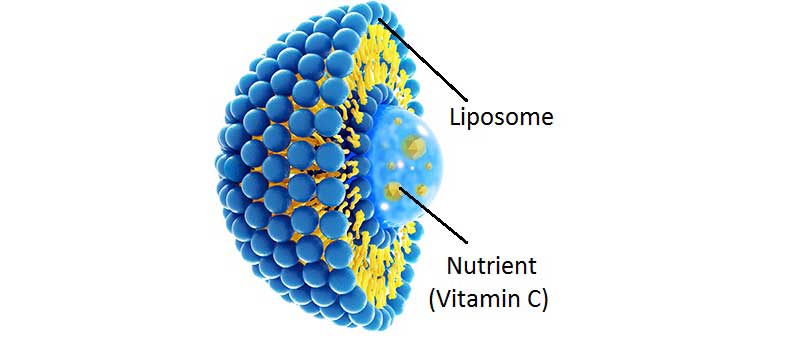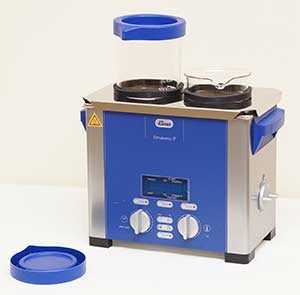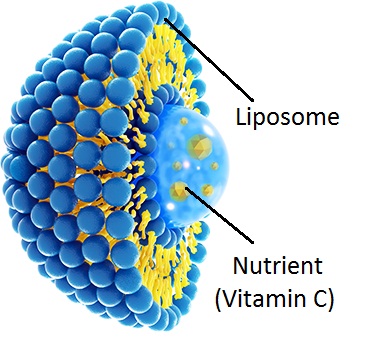
How to Use an Ultrasonic Bath to Make Liposomal Vitamin C

Liposomal encapsulated vitamin C offers a high absorption efficiency vs. taking vitamin C pills and is much more convenient than intravenous administration. Due to the Coronavirus pandemic there has been an increase in demand for vitamin C as a means of protection or treatment while a recent report states that demand for liposomal vitamin C has outpaced that for hand sanitizers*. Because liposomal vitamin C has a short shelf life, this post tells you how to make it yourself using an ultrasonic bath and a beaker kit.
Why Ultrasonic Energy Delivers Superior Liposomal Vitamin C
While it uses a benchtop ultrasonic cleaner, the process employs the power of what is called ultrasonic cavitation to encapsulate ascorbic acid within liposomes. Encapsulation improves the bioavailability of the vitamin C in your body.
Ultrasonic processing is also preferred as a means of reducing the particle size of your product to a diameter as small as 1/2 micron. Smaller particle size may be associated with improved absorption in the body. Individual liposomal particles cannot be seen with the naked eye. If you have great eyesight you may be able to see a 70 micron particle.
Ultrasonic processing liposomal vitamin C is covered in several YouTube videos along with recommendations on how to produce it at home. We’ll not go into detail on the recipes described other than to state it contains lecithin (non GMO recommended) to serve as the lipid and ascorbic acid as the vitamin, separately dissolved in distilled water then thoroughly mixed in a high speed blender. It is then processed in an ultrasonic bath for a length of time based on the recipe.
Ultrasonic Equipment Details
Cavitation is the creation, in a bath, of minute vacuum bubbles produced by ultrasonic transducers powered by the unit’s generator. In a cleaning operation they implode on surfaces to remove contaminants. Here, as noted above, they serve to encapsulate the vitamin C within liposomes less than 1 micron in diameter.
Certain ultrasonic cleaner features apply to the process, others do not.
For example, heating the mixture is not required. Therefore, you do not need to invest in a unit equipped with a heater if making liposomal vitamin C is all you plan to do.
But note that you can get more utility out of a heater-equipped ultrasonic cleaner by also using it to clean various products in your home or workshop. That’s a different topic and many examples are contained in our various blog posts on ultrasonic cleaning.
Processing capacity is important as it relates to the amount of liposomal encapsulated vitamin C you want to make in a batch. Keep in mind that liposomal vitamin C has a limited shelf life in the refrigerator – approximately 30 days according to one post. If you have a large family and they each take two tablespoons a day that helps answer your question about the right batch size.
Ultrasonic frequency is another criterion. It is measured in kilohertz (kHz) or thousands of cycles per second. A frequency of 37 kHz should do the job nicely.
Ultrasonic power is important as the amount of power (designated as watts) relates directly to liposome particle size. More power generally produces smaller liposomes.
We recommend an ultrasonic cleaner equipped with a timer that will shut the unit off when the processing time has elapsed.
Ultrasonic Processing Options for Liposomal Vitamin C

Some of the YouTube examples show ultrasonic processing directly in the ultrasonic cleaner tank. We recommend, instead, processing your mixture in glass beakers. There are reasons for this:
- Beakers allow you to carefully measure batch size
- Pouring from a beaker is much easier and neater than pouring from a tank
- Beakers are easier to clean after each batch is processed
- Tank processing requires extreme care to thoroughly clean the tank to avoid batch-to-batch contamination along with possible damage to the tank itself, and
- If you process in a tank do not use the drain (if so equipped) as it can cause contamination
How to Sonically Process Liposomal Vitamin C in Beakers
First, why beakers vs. glass jars? As explained below sonic energy penetrates the glass walls of beakers to act on the mixture. Thicker glass, such as Mason Jars, absorbs the ultrasonic energy greatly inhibiting formation of liposomes.
Tovatech offers a choice of four beaker kits to support do-it-yourself liposomal vitamin C. Glass beaker capacities are 600 and 1,000 ml (20 oz. or 2.5 cups and 33.8 oz. or 4 cups) depending on the kit you choose. When set to maximum power, the advanced FS P30H kit offers extremely high values of 120 watts effective power and 480 watts peak power enabling you to produce smaller liposomes.
Kits include the ultrasonic unit, beakers, a stainless steel tank cover to support beakers, rubber rings, and beaker caps.
Beakers are suspended in a water/wetting agent (such as liquid dishwashing soap) solution. The rubber rings hold them at the correct position above the bottom of the tank.
After the beakers are filled with your formula and loosely capped, activate the ultrasonic cleaner and set the timer. Ultrasonic energy passes through the beaker walls to act on the formula.
When finished pour your formula into storage containers, seal and refrigerate.
Equipment Maintenance
If you opt for processing liposomal vitamin C using beakers, post-processing tasks are simplified as all you need to do is thoroughly clean your beakers. Check your tank to be sure that the water level is up to the fill line taking into account displacement by the beakers. We recommend you periodically drain and clean the tank following instructions in the user manual.
If you process in the tank itself it must be thoroughly cleaned after each batch to ensure complete removal of residues. Follow the manufacturer’s recommendations and never use abrasive cleaners.
Call Tovatech’s ultrasonic experts for suggestions on the equipment to use if you are making liposomal encapsulated vitamin C in your kitchen.
*This post does not signify Tovatech’s endorsement of vitamin C for prevention or treatment of coronavirus.
